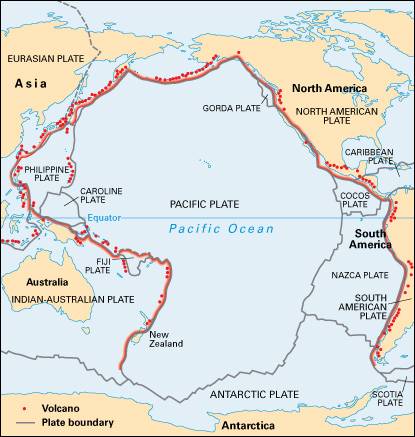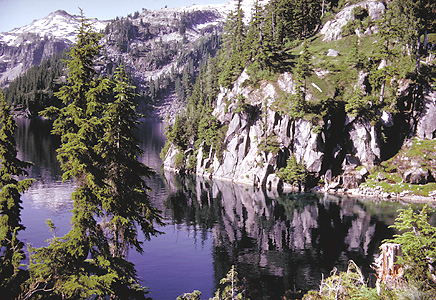Cascadia subduction zone is an area on the northern Pacific Coast of North America that is capable of producing great earthquakes . The zone lies along the edge of the Pacific Ocean off the coast of southern Canada and the northwestern United States . It is about 600 miles (1,000 kilometers) long. In this region, rigid pieces of the Earth’s outer layers, called tectonic plates , converge (come together). Tectonic plates consists of crust, Earth’s outermost layer, and part of the next lower layer, the mantle . Three tectonic plates, called the Juan de Fuca, Gorda, and Explorer plates, make up part of the Pacific Ocean floor. As these oceanic plates slowly collide with the North American plate, their edges sink under its margin. This process is called subduction.
The Cascadia subduction zone makes up part of the Ring of Fire , a region along the edge of the Pacific Ocean that has many volcanoes and earthquakes. The great length of the Cascadia subduction zone makes it capable of producing some of the most powerful earthquakes on Earth. Known as deep megathrust earthquakes, they can occur with moment magnitudes exceeding 9.0. Moment magnitude is a measurement of earthquake strength related to the energy released during the earthquake. Megathrust earthquakes may also thrust portions of the seabed upward, displacing huge amounts of water and forming a tsunami (series of powerful ocean waves).

Scientists have determined that the last deep megathrust earthquake in the Cascadia subduction zone occurred in 1700. This event and a resulting tsunami may be referred to in tales among Native American groups in the region. Historical accounts in Japan record that a large tsunami generated by the earthquake struck that nation. In North America, evidence of the natural disaster is recorded in the form large stands of dead trees. The trees are preserved in what scientists call ghost forests. The trees died suddenly when the earthquake sank the ground more than 6 feet (2 meters), plunging entire forests below sea level .
Geologic activity within the zone has also formed the Cascade Range , a chain of mountains and volcanoes that extends between northern California and southern British Columbia . The range is about 700 miles (1,100 kilometers) long and lies 100 to 150 miles (160 to 240 kilometers) inland from the Pacific Coast. The range was created as oceanic crust subducted under the North American Plate. At boundaries where plates collide, layers of rock in the overriding plate crumple and fold like a tablecloth pushed across a table, forming mountains. As oceanic crust sinks, it is heated and melts. This forms magma (molten rock) that rises through the overlying plate to build the volcanoes of the Cascade Range.

